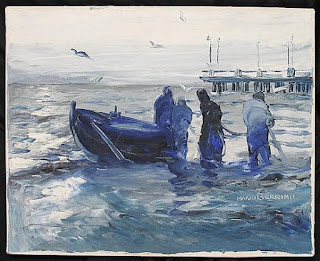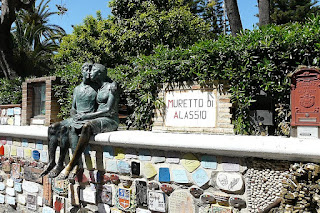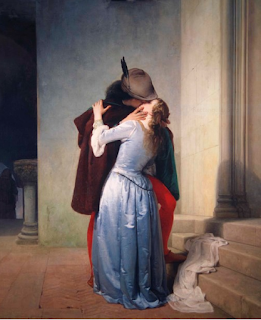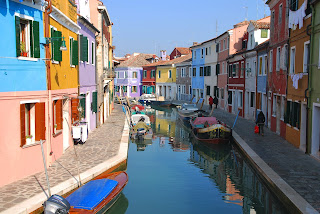Pioneer of perspective also worked in mosaics
_01.jpg) |
| The first panel of Uccello's fresco series, Battle of San Romano, on display at the National Gallery |
The son of a surgeon, Uccello served an apprenticeship in the workshop of the sculptor and goldsmith Lorenzo Ghiberti but made his own mark as a painter and also as a mosaicist, at one time employed to work on the facade of Basilica di San Marco in Venice.
Younger than Ghiberti, Filippo Brunelleschi and Donatello, three giants of the Early Renaissance period, Uccello belonged to a generation of artists eager to move away from the flat, decorative forms of traditional Gothic art. His work is more often characterised by clear colours, well-defined outlines and a dramatic narrative, although he retains the fairytale quality of Gothic.
He was noted for his interest in linear perspective, which helped create a sense of depth in many of his paintings. According to Giorgio Vasari, the 16th century painter and architect whose book, Lives of the Most Excellent Painters, Sculptors, and Architects, led him to become known as the first art historian, Uccello was so fixated with perspective that he would stay up all night, seeking to apply his knowledge of mathematics to ensuring the angles in his pictures and the relative scale were exactly right.
 |
| Uccello's St George and the Dragon echoed the typical themes of traditional Gothic art |
His love of perspective, meanwhile, was no better illustrated than in The Flood and The Waters Receding, part of a 1447-48 fresco depicting Scenes from the Life of Noah, which he painted for the Chiostro Verde of the Basilica of Santa Maria Novella in Florence.
His St George and the Dragon (c1456), which is also kept by the National Gallery in London), and the Miracle of the Desecrated Host (c1467), housed in Urbino’s Galleria Nazionale, are other notable works.
Uccello was born Paolo di Dono or Paolo Doni. His father was from a wealthy Florentine family and his mother from the noble Del Beccuto family, who had three chapels in the church of Santa Maria Maggiore, one of which Uccello would decorate himself. It is not known with certainty why he came to be known as Paolo Uccello, although he often used birds - uccelli - as well as small animals in his paintings as a device to help create perspective.
 |
| Uccello's fascination with perspective is evident in this section of his Scenes from the life of Noah |
Little remains of his work for Ghiberti. The earliest frescoes attributed to him, though now badly damaged, are in the Chiostro Verde of Santa Maria Novella and depict episodes from the Creation.
From 1425 to 1431, Uccello worked as a master mosaicist in Venice. Documentary evidence has come to light suggesting that a mosaic of Saint Peter for the facade of the Basilica di San Marco, which was depicted in Gentile Bellini's 1496 painting, Processione in Piazza San Marco, was Uccello’s. Sadly, if there was such a piece, it no longer exists. Some floor mosaics within the basilica are more confidently attributed to Uccello.
After returning to Florence, where he was to stay for most of the rest of his life, he executed works for various churches and patrons, most notably the Cattedrale di Santa Maria del Fiore, the city’s Duomo.
 |
| This mosaic on the floor of Basilica San Marco in Venice is attributed to Uccello |
Later, he painted the four heads of the prophets that surround the clock on the Duomo’s interior west facade clock, and designed a number of stained glass windows.
The three paintings celebrating the Battle of San Romano are thought to have been executed between 1438 and 1440. The three panels were exhibited until 1784 in a room in the Medici Palace on Via Larga in Florence.
Married in 1453 to Tommasa Malifici, Uccello had a son, Donato, with whom he worked towards the end of his life, and a daughter, Antonia, who became a Carmelite nun.
In poor health, Uccello stopped working in 1470. His last will and testament was dated November 11, 1475, about a month before he died. He was buried in his father's tomb in the church of Santo Spirito in Florence.
 |
| The magnificent Florence Duomo, topped by Brunelleschi's colossal dome, towers over the city |
Florence’s Duomo - the Cattedrale di Santa Maria del Fiore - with its enormous dome by Filippo Brunelleschi and campanile by Giotto, is one of Italy's most recognisable and most photographed sights, the dominant feature of the city’s skyline. From groundbreaking to consecration, the project spanned 140 years and involved a series of architects. Arnolfo di Cambio, who also designed the Basilica of Santa Croce and the Palazzo Vecchio, was the original architect engaged and it was largely to his template that the others worked. When he died in 1410, 14 years after the first stone was laid, he was succeeded by Giotto, who himself died in 1337, after which his assistant Andrea Pisano took up the project. Pisano died in 1348, as the Black Death swept Europe, and a succession of architects followed, culminating in Brunelleschi, who won a competition - against Lorenzo Ghiberti - to build the dome, which remains the largest brick-built dome ever constructed.
.jpg) |
| The facade of the Basilica of Santa Maria Novella, designed by Leon Battista Alberti |
The Gothic Basilica of Santa Maria Novella in Florence, for which Uccello created his Scenes from the Life of Noah fresco series, which included The Flood and The Waters Receding, was built in the 13th century by the Dominicans and can be described as the city’s first great basilica. This church was given the suffix ‘Novella’ - new - because it was built on the site of the 9th-century oratory of Santa Maria delle Vigne. The new church was commissioned by wealthy Florentine wool merchant Giovanni di Paolo Rucellai and designed principally by Leon Battista Alberti. The church, recognisable for its white marble façade, was built between 1456 and 1470. A list of its notable artworks reads like a roll call of masters of Gothic and early Renaissance painting and sculpture, including Botticelli, Bronzino, Brunelleschi, Duccio, Ghiberti, Ghirlandaio, Lippi, Masaccio, Pisano, Uccello and Vasari. The city’s nearby main railway station takes its name from the basilica.
Also on this day:
1813: The birth of composer Errico Petrella
1903: The birth of painter Giuseppe Dossena
1907: The birth of actor Amedeo Nazzari
1921: The birth of football administrator Giuseppe 'Peppino' Prisco
1936: The death of playwright and novelist Luigi Pirandello








_2.jpg)




.jpg)


.jpg)

.PNG)












